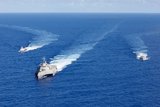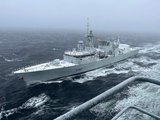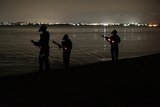DCNS, Thales and ECA win DGA contract to study drones for mine countermeasures
The French defence procurement agency (DGA) has awarded DCNS, Thales and ECA a major study contract that is expected to lead, around 2011, to a demonstrator of a new mine countermeasures solution dubbed Espadon*.
Today, mine countermeasures (MCM) is typically performed by dedicated vessels known as minehunters. MCM operations expose minehunter crews to considerable danger due to the simple fact that these vessels operate in known mine fields.
With many navies expected to renew their MCM systems over the coming decade, DCNS, Thales and ECA have put forward a joint solution using a type of naval drone known as an unmanned surface vehicle. USVs offer the key benefit of keeping minehunter crews out of harm's way.
The Espadon solution comprises a minehunter, two USVs and autonomous underwater vehicles (AUVs). While remaining at all times at a safe distance from the mine field, the minehunter or similar dedicated vessel will deploy and control the USVs, each programmed specifically to operate in mine fields. The USVs, in turn, will deploy AUVs, a smaller and completely autonomous type of subsea naval drone carrying sensors and robotic devices to detect and neutralise naval mines. On completing their mission, the AUVs return to the USVs and the USVs to the mother vessel.
With Espadon, DCNS, Thales and ECA will be the first team in the world to evaluate USVs deploying AUVs for full-scale mine countermeasures.
The Espadon studies will be shared in such a way as to ensure that each partner contributes its specific expertise in MCM.
In addition to acting as the lead contractor to the DGA for the overall project, DCNS is responsible for the USV platform and the interface with the mother vessel.
Thales is responsible for the USV, MCM outfitting and the sensor module, comprising an AUV and a towed sonar for mine detection, identification and location. Thales is also responsible for communications between the different components.
ECA is responsible for the design and development of the autonomous underwater vehicles, the AUV launch and recovery system and the USV remote control system.
More from Uncrewed Vehicles
-
![What's next for the Pentagon after the Replicator programme?]()
What's next for the Pentagon after the Replicator programme?
Although the Replicator initiative has made several accomplishments, there are still multiple gaps to plug across the US Department of Defense (DoD) and its services.
-
![Cummings Aerospace showcases Hellhound loitering munition designed for US Army’s LASSO programme (video)]()
Cummings Aerospace showcases Hellhound loitering munition designed for US Army’s LASSO programme (video)
Cummings Aerospace presented its turbojet-powered Hellhound loitering munition at SOF Week 2025, offering a man-portable solution aligned with the US Army’s LASSO requirements.
-
![SOF Week 2025: PDW unveils attritable FPV drone for SOF operations at scale]()
SOF Week 2025: PDW unveils attritable FPV drone for SOF operations at scale
PDW has revealed its Attritable Multirotor First Person View drone at SOF Week 2025, offering special operations forces a low-cost, rapidly deployable platform for strike and ISR missions, inspired by battlefield lessons from Ukraine.
-
![SOF Week 2025: Teledyne FLIR white paper provides guidance on reusable loitering munitions]()
SOF Week 2025: Teledyne FLIR white paper provides guidance on reusable loitering munitions
Teledyne FLIR is highlighting the emerging requirements for 'recoverable and re-usable' loitering munitions across the contemporary operating environment during this week’s SOF Week conference in Tampa, Florida.
-
![SOF Week 2025: Kraken Technology group debuts K3 Scout USV in North America]()
SOF Week 2025: Kraken Technology group debuts K3 Scout USV in North America
High-performance maritime industry player Kraken Technology Group, based in the UK, has used the SOF Week conference in Tampa, Florida this week to debut its K3 Scout uncrewed surface vessel (USV) to the North American market.
-
![Palladyne AI and Red Cat to demonstrate capabilities for autonomous drone swarms to the US military]()
Palladyne AI and Red Cat to demonstrate capabilities for autonomous drone swarms to the US military
Red Cat and Palladyne AI recently conducted a cross-platform collaborative flight involving three diverse heterogeneous drones.

























